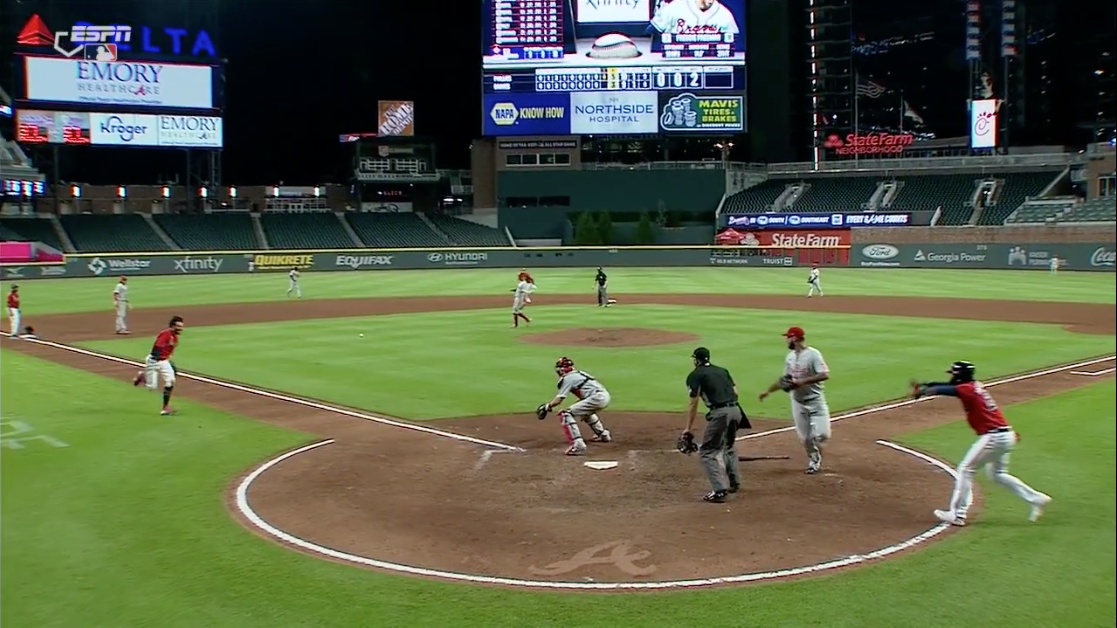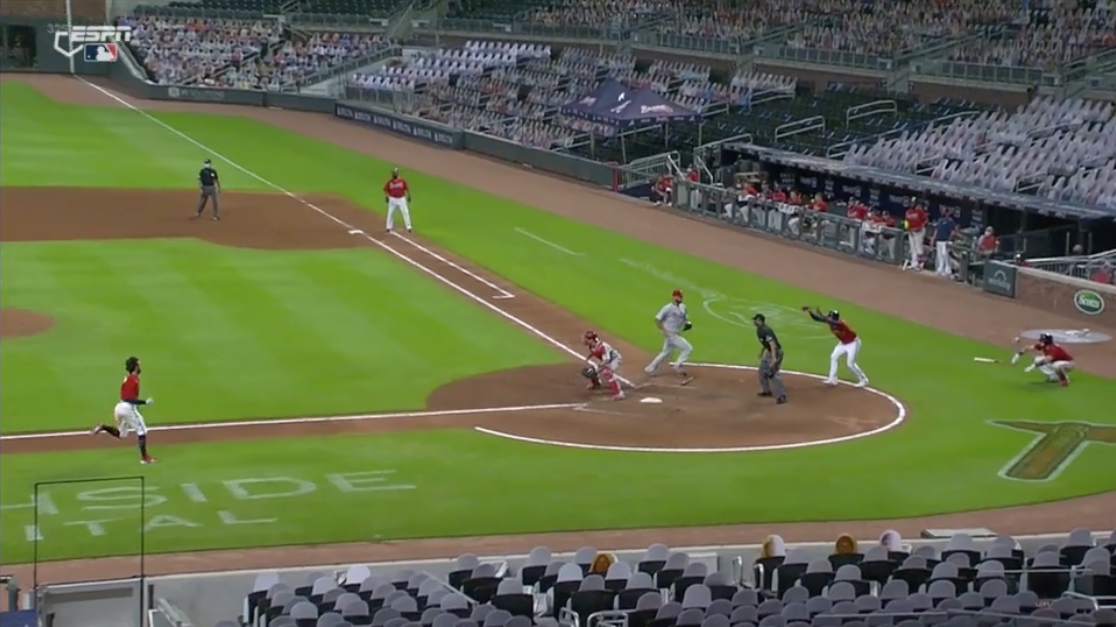The Final Play of Last Night’s Braves Game
With two outs in the bottom of the ninth inning of last night’s game between the Braves and Phillies, the visiting Phillies were holding on to a two-run lead. Dansby Swanson stood on first base with Adeiny Hechavarría on second. Freddie Freeman was facing off against new Phillies acquisition Brandon Workman. In terms of compelling endings, this is pretty close to what you hope for. One of the better hitters in the game had a chance to hit a walk-off home run to end the game, while making an out would mean victory for the other side. Freeman did get a hit, pushing a double into the gap, but the game ended when Swanson was thrown out at home trying to score the tying run. The play, already compelling given the game state, was made more interesting by two factors:
- Andrew Knapp might have blocked the plate in violation of the rules designed to prevent collisions at home.
- Swanson decided to try to score the tying run on the play, but made the final out instead.
Before getting to the collision rule and whether Knapp was where he shouldn’t have been, let’s first consider Swanson’s decision to attempt to score from first base. While Freeman hit the ball pretty far, it was cut off by Roman Quinn. One of the fastest runners in the game, Quinn got to the ball in the gap before left fielder Andrew McCutchen. While McCutchen’s arm strength isn’t terrible, it isn’t much more than average, while Quinn has thrown an easy 87 mph pitch from the mound, and made this throw earlier this month:
Last night, Quinn made a strong, accurate throw to Didi Gregorius, who then made a bouncing throw to the plate. The throw arrived just in time to get Swanson. As for whether Swanson should have tried to score, the decision is actually a fairly easy one. Here’s the win expectancy chart for Swanson’s decision, with the numbers coming via our WPA inquirer:
| Decision | Run Differential | Leverage Index | Braves Win Exp. |
|---|---|---|---|
| Stays at Third | -1 | 8.28 | 24.20% |
| Scores | 0 | 4.65 | 62.70% |
If Swanson stays on third, the Braves have about a one-in-four shot at winning the game as they still need another hit — or a wild pitch or an error — to score a run and tie the game. If Swanson makes it home safely and Freeman ends up standing on third base as the potential winning run, the Braves have a 62.7% chance of winning the game. If Swanson decides to try to make it home, he risks losing 24.2% in win expectancy should he make an out, versus gaining 38.5% in win expectancy if he is safe. That means Swanson should try for home if he believes he has a 39% chance of being safe. That’s a pretty low threshold to make running worth it. Here’s where Swanson was while rounding third — note that Gregorius is nearly out of the frame as he gets the throw from Quinn:

With Gregorius 150 feet or more away from the plate, any hiccup in his catch, or a throw that ends up a little up the line or that sails slightly, would have allowed Swanson to make it home. Only needing to believe he’d make it home safely with 39% confidence, Swanson’s decision was a good one, despite the result. (On the broadcast, Alex Rodriguez noted that he would have been helped by a larger secondary lead with the first baseman playing behind him.)
As for Knapp’s play at the plate, here’s a quick reminder of the rule in question:
Unless the catcher is in possession of the ball, the catcher cannot block the pathway of the runner as he is attempting to score. If, in the judgment of the umpire, the catcher without possession of the ball blocks the pathway of the runner, the umpire shall call or signal the runner safe. Not withstanding the above, it shall not be considered a violation of this Rule 6.01(i)(2) if the catcher blocks the pathway of the runner in a legitimate attempt to field the throw (e.g., in reaction to the direction, trajectory or the hop of the incoming throw, or in reaction to a throw that originates from a pitcher or drawn-in infielder). In addition, a catcher without possession of the ball shall not be adjudged to violate this Rule 6.01(i)(2) if the runner could have avoided the collision with the catcher (or other player covering home plate) by sliding.
And while not directly applicable in this case, the comment to the rule provides further clarity about the conditions necessary for violation of it:
A catcher shall not be deemed to have violated Rule 6.01(i)(2) unless he has both blocked the plate without possession the ball (or when not in a legitimate attempt to field the throw), and also hindered or impeded the progress of the runner attempting to score. A catcher shall not be deemed to have hindered or impeded the progress of the runner if, in the judgment of the umpire, the runner would have been called out notwithstanding the catcher having blocked the plate.
The play on the field was reviewed and Knapp was deemed not to have violated the rule. The umpires pretty clearly got the call right. Here’s a screenshot of where Knapp was standing as the ball was coming in:

Knapp is standing in front of the plate, and Swanson has a direct path to it. For completeness’ sake, here’s another angle:

Again, Knapp in front of the plate, and Swanson has a clear path to home. Brian Snitker took issue with the play after the game, saying:
He was sitting there pretty good, but they’re not calling that anymore. They need to take that off the book and just start blowing up catchers again.
Perhaps the comment was just the heat of the moment after losing a tough game making itself known. Maybe that call is being made less, but a lot of that likely has to do with compliance with the rule. We haven’t had many notable collisions at home since the rule was enacted, and if an umpire can determine that the runner would have been out even if the catcher hadn’t been blocking the plate, there aren’t a lot of calls to be made in that arena. Blowing up catchers would be a terrible idea — the rule has legitimately changed behavior to create a safer game. In any event, Knapp wasn’t blocking the plate before the ball arrived, though he obviously moved in front of the plate to field the throw as we see below:
Knapp moved into Swanson’s path to field the ball, which is definitely within the rules.
In the end, Swanson made the correct decision to try to make it home, even if he was out. Knapp followed the appropriate collision rules, even if he ended up between Swanson and home plate. It was an exciting ending to a good game, and the decisions by Swanson, Knapp, and the umpires should be without controversy, even if Snitker’s comments raise some eyebrows.
Craig Edwards can be found on twitter @craigjedwards.

As a Braves fan, I think you make excellent points! Thanks
As a Braves fan I just couldn’t find the gall to get upset given that for the past 2-3 years the “blocking the plate” rule has basically never been called (and this wasn’t even a good example of clear plate blocking, and there are many). The only thing I was upset about was that Knapp managed to hold onto the ball.